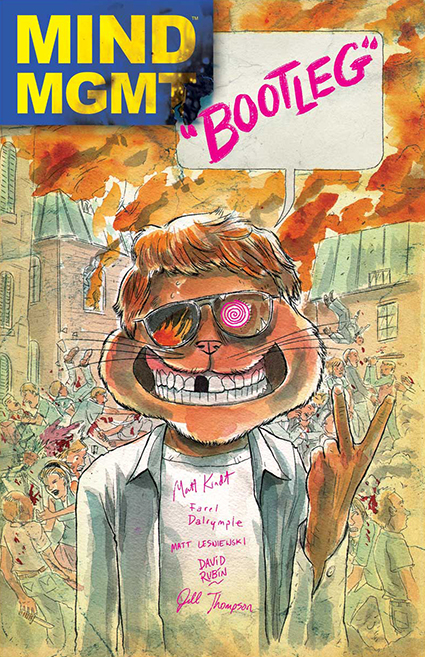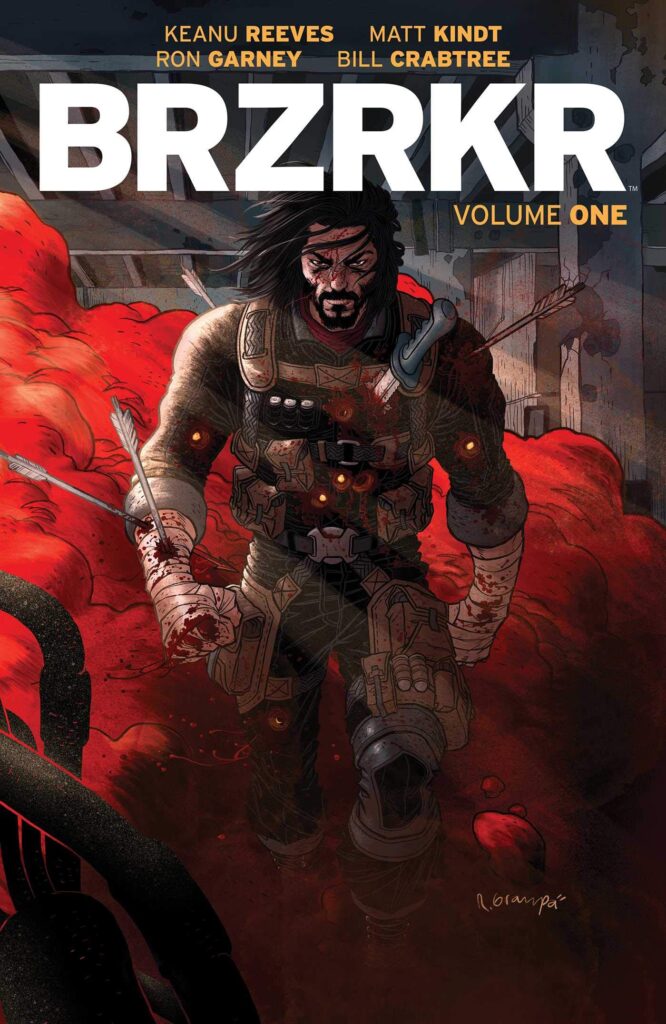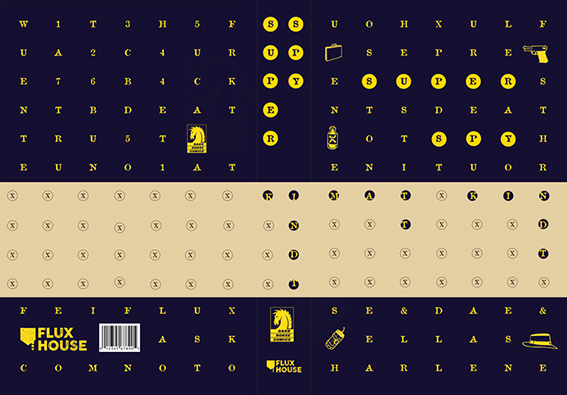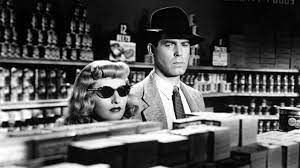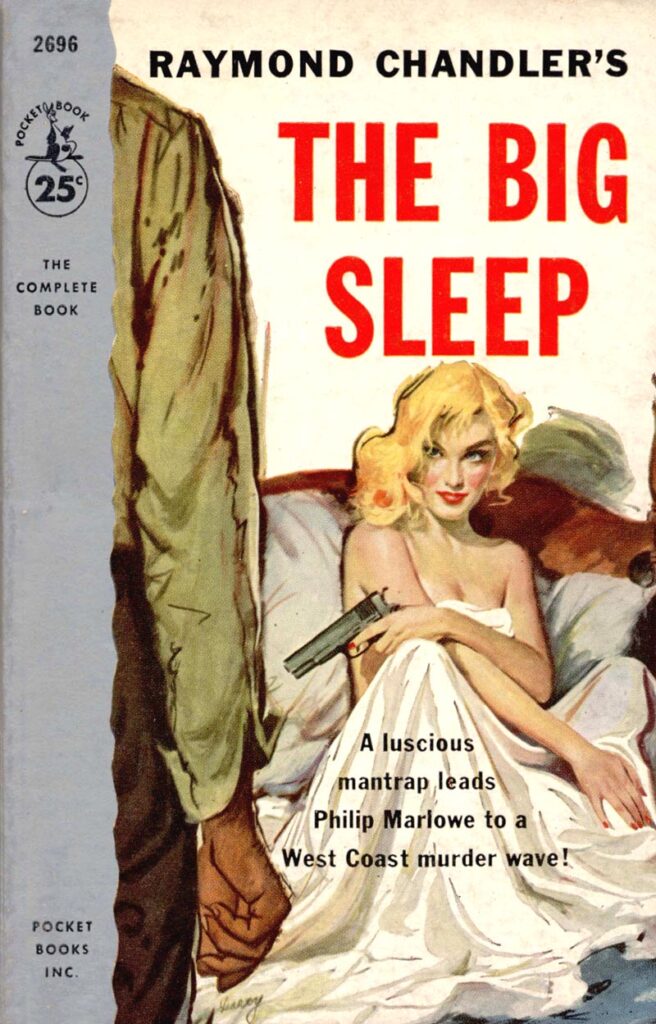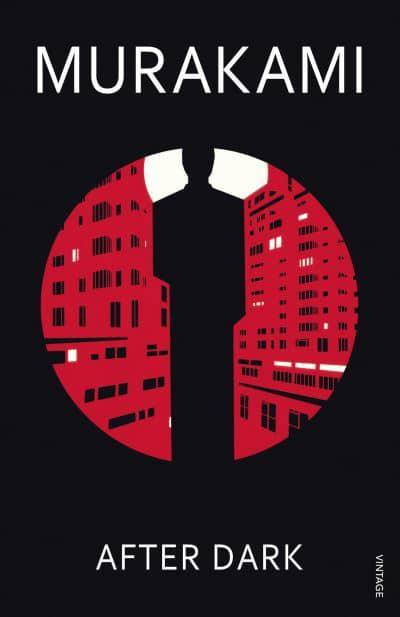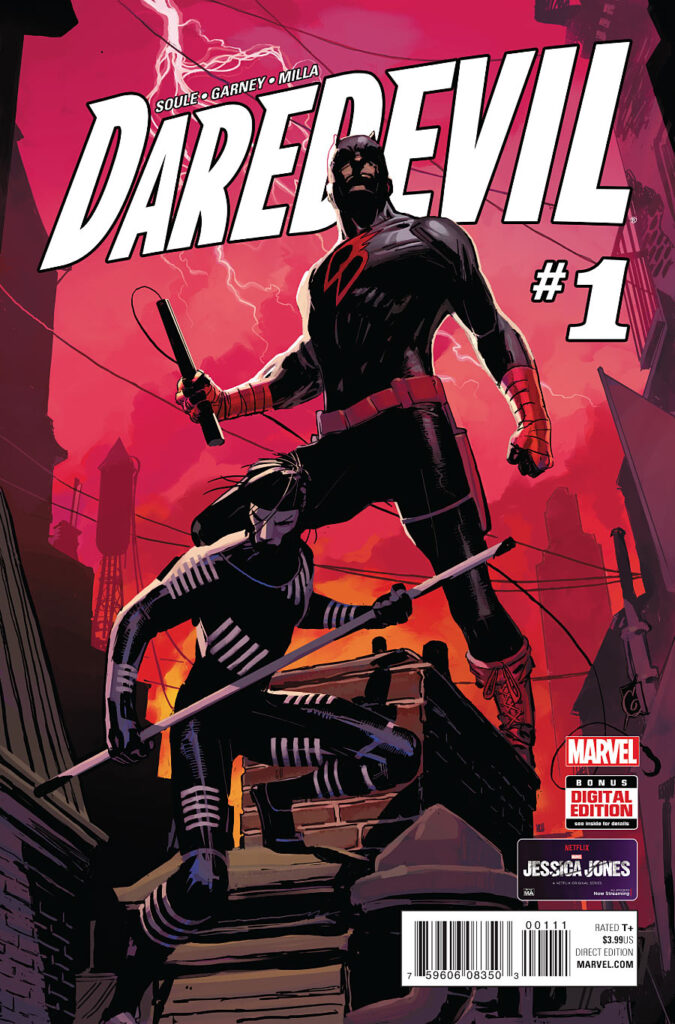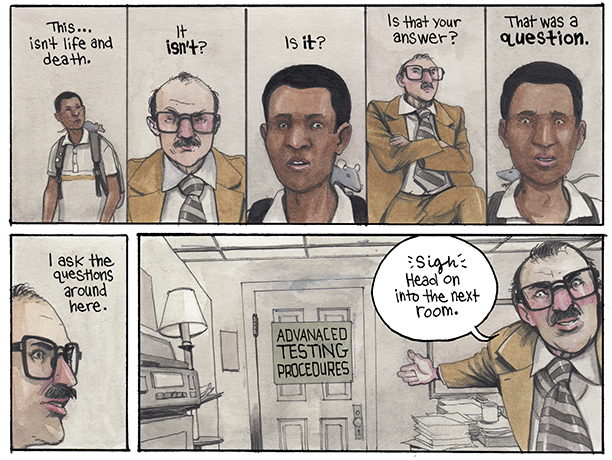Crimeculture Interviews Acclaimed Cartoonist Matt Kindt on the launch of Flux House
Crimeculture is delighted to have the opportunity to talk with bestselling writer and cartoonist Matt Kindt about his new venture. Matt is collaborating with Dark Horse Comics to launch Flux House, a boutique imprint that will feature his writing and art.
Since the mid-1980s, Dark Horse Comics has developed into an extraordinary and groundbreaking publisher of comic books and graphic novels. Their publications have included Frank Miller’s Sin City, Mike Mignola’s Hellboy and Stan Sakai’s Usagi Yojimbo. In 2010, they published their first work by Matt Kindt, a Super Spy short story, and since that time they have published numerous examples of his innovative art and writing, including Mind MGMT, Dept. H, and BRZRKR. They are launching the new Flux House imprint in July 2022 with the release of a 4-part mini-series, MIND MGMT: BOOTLEG, which will give readers “crime, science fiction, and humor stories, all told and presented in startling and untraditional ways.”
Crimeculture: What do you think accounts for the remarkable success of Dark Horse in publishing such a range of inventive art and writing? Are there any Dark Horse artists in particular who have inspired your work? What have you most enjoyed about working on your own projects with them?
I have to give a lot of credit to Mike Richardson – he’s been at the helm of Dark Horse since before I’d even broken into comics. And I think the real key there is that the person in charge is a huge fan of comic books as a medium. You have to have someone in power at the top with a passion for comics and a good eye for them – but also the humility to be open to ideas and books that are outside the norm – stuff that pushes the envelope – you have to be willing to take risks on the publishing side. Those risks are equally mirrored on the creative side as well. In the 90s they were publishing Cheval Noir – a great anthology of all kinds of material – I mean – it had The World’s Angriest Dog comic strip written and drawn by David Lynch in it – I’ll never forget it. That along with the Legends imprint – Mignola, Byrne, Darrow, Miller and Paul Chadwick – all huge influences on me early on. So I’m really just born of that DNA and Dark Horse has historically been a good home for pulpy genre stuff with a twist and some heart.
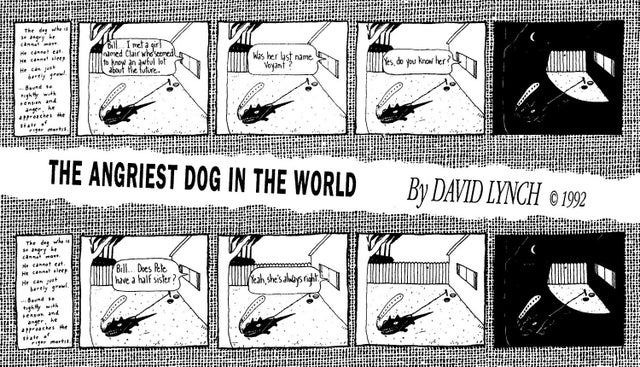
Crimeculture: In your storytelling and art, you aim to push the boundaries. Talking about the unconventional nature of your storytelling in Flux, you’ve discussed the strong influence of absurdism, surrealism and other avante-garde art movements. Could you talk a bit about the ways in which Flux will experiment with breaking out of more traditional forms?
I’ve been writing and drawing comics for 20 years and what started to hit me the last few years is this sort of unconscious knowledge you pick up when you write thousands of pages of comics. Dave Sim once said that you have to make 1,000 pages of comics before you make your first good one. That always stuck with me. My thousandth page was somewhere in the middle of my book Super Spy. The flip side to that is – after 10,000 pages of comics – something else happens. You start just hitting the beats of the story and making these practiced marks on the page that come naturally now. I won’t say it’s easy – but there is a part of your brain you stop using to make basic decisions because you’ve “figured it out.” That’s what I’m trying to fight here. My wife and I went to this exhibit at The Phillips Collection in Washington, DC. They had more Picasso in one place than I’d ever seen before. Now, I’m not a huge fan of Picasso, aesthetically. And as a person? I’m even less sure. But what struck me about that wide range of work was that he was constantly learning and unlearning and learning again. He was classically trained and spent many years trying to undo that. Now, when I talk about this to my Dad – he’s thinking I’m crazy – why would you unlearn years of training? But there is a difference between craft and art. I think over 20 years you learn craft. But at the expense of the art. You stop using that part of your brain that thinks differently. Or you just end up thinking differently in the same way.
That’s the pattern I’m breaking out of. Let’s play with format. Why does everything need to be in single 22 page issues and a standard format. Well. I get the collectable and financial aspects. But that’s an argument against it really. I’ve had to stop myself through every part of the process and question why I’m doing it the way I’m doing it. Why these colors? Why this paint? Why that paper? Why spies and crime? Ultimately – it’s just about having fun making stories. If fun is being had – it’s going to come out on the page and in the books. I can’t reinvent everything. I still love crime as a genre and spies. So that’s all going to be in there. I’m pushing into some horror-esque genre tropes for fun – to see what comics can do with that. I think there’s a way to do a House of Leaves style book but in comics. Something that uses pictures and words in completely new ways.
I’m trying to execute this approach down the line – with everyone at Dark Horse – a lot of hands work to make these books possible – so from editorial to production and even PR – I’m asking everyone to do things a new way – or at least pause a moment before we do things the way we’ve always done. Let’s have fun – all of us. Do something that’s a little risky. Something that may not work – just to see if it will.
For example…I’m drawing a new spy/crime book now that my wife (Sharlene Kindt) is painting and I’m designing the covers and the look of the thing. It’s going to come out as normal comic book issues – but the covers are going to be covered up by grocery store paper bags to disguise them on the shelf. With some secret little hidden messages on them…but I want them to look like grocery bags for covers. As a way to kind of disguise them as part of the theme of the book.
Crimeculture: Flux carries on the fascination of MIND MGMT with exploring “the darkest parts of the world,” and you’ve said in our initial correspondence that you’re a great fan of classic noir and neo noir. From the time the Crimeculture website was created, one of our strongest interests has been in noir and neo-noir film and in the fictional roots of the noir thriller – the pulp fiction that transformed post-World War II American paperback publishing. Could you tell us what for you have been some of the most influential pieces of literary and cinematic noir?
Hammet and Chandler to start. Love all of the books. And that goes for all of the adaptions to film as well. I think Double Indemnity was a huge influence particularly. I had a sequence in the original MIND MGMT series where they hire Salvador Dali to direct a sequel to Double Indemnity and it’s called…Triple Indemnity. It’s ridiculous but also kind of creepy – playing on the themes of the original movie but in a twisted way. I did storyboards for the movie – and that was part of the comic – done as storyboards.
We’re working on a television adaptation now (hopefully soon to be announced) – so imagine an episode of the show that is Triple Indemnity – 90 minutes long…but MIND MGMT style.
MIND MGMT bootleg plays with this theme as well – with a (possibly) delusional character starring in a prequel to Double Indemnity and it’s just called…INDEMNITY. It could be a franchise.
Last summer I started reading through the entire series of Hard Case Crime books – there are a lot. Haven’t finished yet – but having a great time with those. Amazing covers and super pulpy stories. I’ve been revisiting Patricia Highsmith this summer – the Ripley books. But probably the most influential to me is The Big Sleep. I love that as a teenager I saw that movie maybe 3 times before I realized there was a pornography ring in it. The way it’s so subtly done. It’s like a James Bond movie in a way – you just go along for the ride and don’t really digest the actual plot. It wasn’t until I’d read the book and then watched the movie again and then it’s like…oh….wow. It’s a subtle darkness that I really like – something I strive for in my comics – it’s fun and has all the typical crime/pulp trappings – but underneath it – there’s a kind of sadness and heartbreak that sucker punches you.
Crimeculture: Amongst contemporary noir influences, you’ve mentioned the films of David Lynch and the novels and stories of Haruki Murakami. What is it that most draws you to their work?
I really enjoy and respect the grounded nature of both of their works. It starts with a murder and then goes off the rails in unexpected ways. I love sitting in a movie or reading a book and having literally no idea what’s going to happen next – but also feeling like anything could happen. It’s rare to get that feeling as a writer. I can’t help but unconsciously dissect movies and books while I’m watching them. You get how they’re made. There’s a bit of an adrenaline rush when you watch something that you realize isn’t playing by the rules at all. Sometimes the endings are terrible or it really does completely go off the rails…but that’s all fuel for me. Inspiration. I’m not ever interested in doing the hard-drinking, divorced guy that listens to jazz records and struggles to pay his bills while solving a crime kind of thing. But I love having that trope of a character in a story and then torturing him in some strange way. So I don’t mind that he exists – without tropes – what is there to subvert?
Crimeculture: You’ve been praised for your skill in creating a compelling world of “weird, paranoid storytelling”, and you’ve said in talking to The Creative Independent that you find character and how the story is told more interesting than plot. What, for you, are the most interesting characters inhabiting this kind of world? Can you give us an example of a character it has been especially fascinating for you to create in the new series?
I wrote a story called Mr. Mammoth that debuted in France this year – and will be out with Flux House in English at the end of 2022. It has a private detective who’s struggling to pay his bills, probably likes jazz records and drinks a bit. But he’s HUGE – maybe seven feet tall and covered in scars. And he’s a pacifist…that gets beat up a lot. He’s not good at fighting. But with this guy we had a lot of fun exploring some tropes and turning them on their head. Not just with his character but with his role as a protagonist. I don’t want to spoil it but it’s one of my favorite endings I’ve written.
As I write this I think what I’m going for is a kind of Paul Auster vibe…with an EC comics ending.
Crimeculture: The new Flux House imprint promises an untraditional combination of crime fiction and science fiction, and your other work also demonstrates a strong interest in the exciting ways in which these genres can intersect: can you tell us more about the art of bringing this combination alive in your own work?
I’d grown up reading Frank Miller’s Daredevil and I loved it. I had a revelation when I was in my 20s – his Daredevil was just crime fiction set in a superhero universe. Wow. So that just opens it up. Same with Bladerunner as private eye noir – with sci-fi. I love all genre. And the beauty of crime fiction is that you can apply it to anything. So I realize (only now) that I’m doing a story about an evil cat that is horror/crime…and astory about an idiot-spy who’s taking on a ring of assassins…and two sci-fi stories that take place on different planets…but very much have human/alien trafficking, drugs, and murder all over the place.
Crime, like love, is universal and there is a never ending supply of it.

